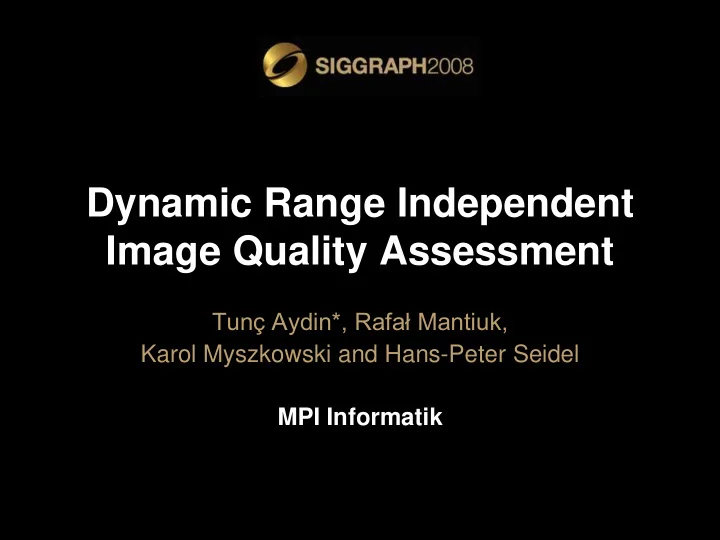

Dynamic Range Independent Image Quality Assessment Tunç Aydin*, Rafał Mantiuk, Karol Myszkowski and Hans-Peter Seidel MPI Informatik
Image Quality Assessment
Example Applications Image Compression Global Illumination Image Processing Speed up rendering How much Benchmarking without affecting compression systems and quality without visible algorithms [Myszkowski 2002] artifacts? [Dabov 2008]
Subjective Experiments Rate Quality of the the distorted image ? Quality + Reliable - High cost
Simple Quality Metrics Reference Random Noise Blur ~15% Decreased Luminance MSE ~ 280 MSE ~ 280 MSE ~ 280 ! Based on the Differences between Images Examples: Mean Squared Error (MSE), Peak Signal to Noise Ratio (PSNR)
Human Visual System (HVS) Based Metrics ~15% Decreased Distortion Random Noise Distortion Luminance Map Map Probability of Detection: Based on the Visible Differences between Images Examples: Visible Differences Predictor (VDP) [Daly 93], HDR-VDP [Mantiuk et al. 05], Visual Discrimation Model (VDM) [Lubin 95]
From Distortion Magnitude to Structural Similarity Distortions may be Contrast Reference Enhancement Visible but Not objectionable Measure the Preservance of Image Structure Examples: Structural Similarity Index Metric (SSIM) [Wang et al. 04]
Visibility Structure Simple metrics No No HVS based Limited or full No metrics dynamic range Calibration Structural challenging due similarity Yes to “abstract” based metrics parameters Our approach: Hybrid of HVS and Structural Similarity
Focus Point: Image Pair with Different Dynamic Ranges Similar appearance … … yet very different luminance
Outline Detecting visibility thresholds Full Dynamic Range Human Visual System (HVS) Model Detecting structural changes A set of new distortion measures Advantages over previous work Possible applications
Human Visual System (HVS) Model … of the entire visible dynamic range
Human Visual System Model [ LUMINANCE ] Light Luminance Contrast Scattering Masking Sensitivity [ JND ] Channel Decomposition
Decreased sensitivity due to glare around bright spots [Deeley et al. 1991] Light Luminance Contrast Channel Scattering Masking Decomposition Sensitivity
Decreased sensitivity due to glare around bright spots [Deeley et al. 1991] Light Luminance Contrast Channel Scattering Masking Decomposition Sensitivity
# of JNDs Log Luminance Transform image luminance to Just Noticeable Difference (JND) Space [Mantiuk et al. 2005] Light Luminance Contrast Channel Scattering Masking Decomposition Sensitivity
Contrast Low Low Sensitivity Sensitivity Spatial Freq. Decreased Sensitivity of very low and high frequencies [Daly 1993] Light Luminance Contrast Channel Scattering Masking Decomposition Sensitivity
6 Frequency Bands … . . . . . . … 6 Orientations Low Pass Image Cortex Transform [Watson 1987, Daly 1993] Light Luminance Contrast Channel Scattering Masking Decomposition Sensitivity
Distortion Measures
Loss of Visible Contrast REFERENCE Visibility Threshold Contrast
Loss of Visible Contrast REFERENCE Visibility Threshold Contrast TEST
Loss of Visible Contrast Reference Test (Clipping) Distortion map
Amplification of Invisible Contrast Visibility Threshold Contrast REFERENCE
Amplification of Invisible Contrast TEST Visibility Threshold Contrast REFERENCE
Amplification of Invisible Contrast Reference Test (Contouring) Distortion map* *For clarity, visible contrast loss is not shown
Reversal of Visible Contrast REFERENCE Contrast
Reversal of Visible Contrast REFERENCE Visibility Threshold Contrast Visibility Threshold TEST
Reversal of Visible Contrast Local contrast Reference reversal
No Structural Distortion Visibility Threshold Visibility Threshold
Visualization
Advantages over previous metrics
Case Study Local Gaussian Blur HDR Test HDR Reference LDR Test LDR Reference
(1) HDR pair HDR-VDP SSIM Our Metric Loss Distortion Amplification Reversal
(2) LDR pair HDR-VDP SSIM Our Metric Loss Distortion Amplification Reversal
(3) HDR test, LDR reference HDR-VDP SSIM Our Metric Loss Distortion Amplification Reversal
(4) LDR test, HDR reference HDR-VDP SSIM Our Metric Loss Distortion Amplification Reversal
Detecting distortions Sharpening Blur REFERENCE HDR-VDP SSIM
Detecting “types” of distortions Sharpening Blur REFERENCE Loss Our Amplification Method Reversal
Applications
TMO Evaluation REFERENCE PATTANAIK FATTAL Loss Amplification Reversal
Inverse TMO Evaluation REFERENCE LDR2HDR Loss Amplification Reversal
Display Comparison (1) BrightSide DR37-P HDR Display (2000 cd/m 2 ) REFERENCE Loss Amplification Reversal
Display Comparison (2) Barco Coronis 3MP LCD Display (400 cd/m 2 ) Loss Amplification Reversal
Display Comparison (3) Samsung SGH-D500 Cell Phone Display (30 cd/m 2 ) Loss Amplification Reversal
Summary • Hybrid approach: HVS and structure • Comparing different dynamic ranges • Detecting “type” of distortions • Applications on (inverse) tone mapping and display comparison • TODO – Color – Supra-Threshold
Decreased sensitivity due to glare around bright spots [Deeley et al. 1991] Light Luminance Contrast Channel Scattering Masking Decomposition Sensitivity
Recommend
More recommend